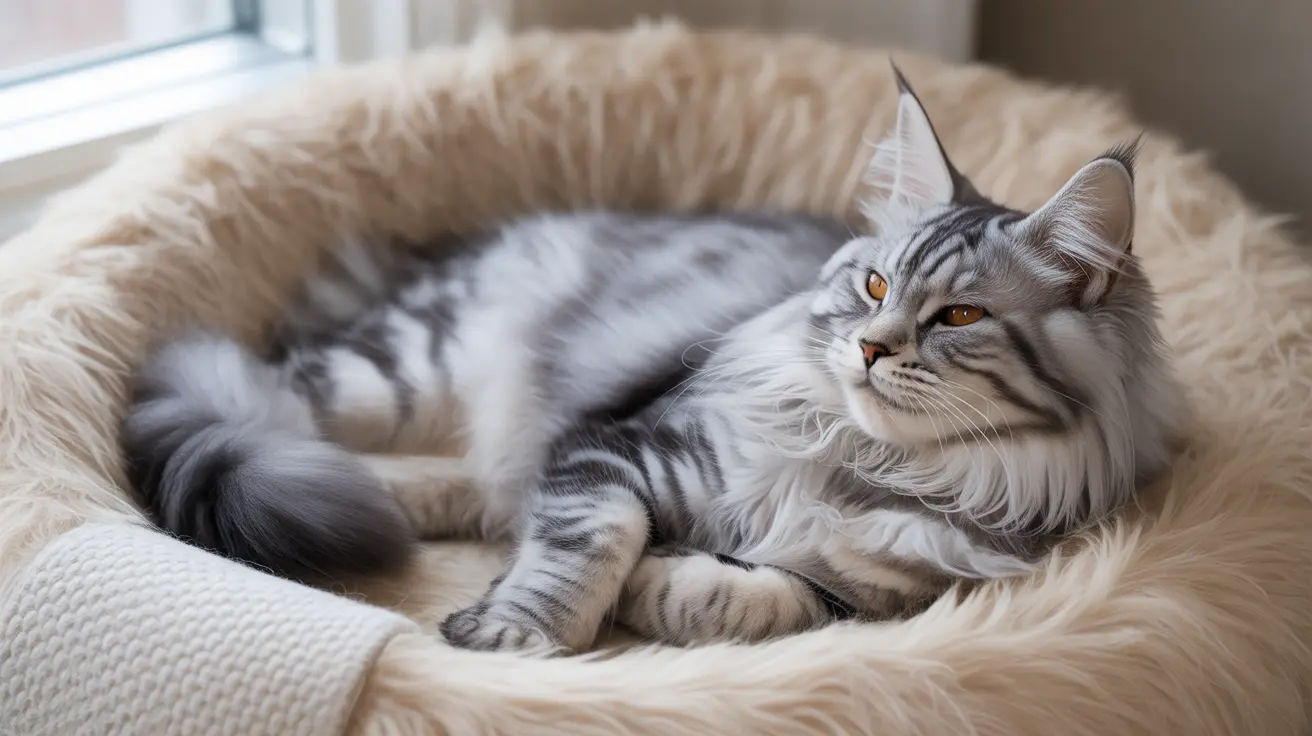Why Do Cats Sleep on Their Left Side: The Surprising Science Behind Feline Sleep Positions
Have you ever noticed your cat curled up on their left side more often than their right? This seemingly simple sleeping habit is actually a fascinating example of evolutionary adaptation that has helped cats survive for thousands of years. Recent groundbreaking research has revealed that cats overwhelmingly prefer to sleep on their left side, and this behavior is deeply rooted in neurological mechanisms designed to keep them safe during their most vulnerable hours.
Understanding why cats sleep on their left side offers valuable insights into feline behavior, brain function, and survival instincts. For cat owners and animal behavior enthusiasts, this knowledge can help you better appreciate the complex nature of your feline companion and even provide clues about their overall well-being and comfort levels.
The Science Behind Left-Side Sleeping Preference
A comprehensive international research study conducted by teams from the University of Bari Aldo Moro (Italy), Ruhr University Bochum (Germany), Medical School Hamburg (Germany), University of Prince Edward Island (Canada), and Kafkas University (Turkey) has provided concrete evidence for cats' left-side sleeping preference. Published in the prestigious journal Current Biology in 2025, this groundbreaking research analyzed 408 YouTube videos of sleeping cats to document their natural sleeping positions.
The results were striking: approximately two-thirds of the cats studied chose to lie on their left side during sleep. This statistically significant preference indicates that the behavior is not random but rather a measurable, evolutionarily-driven adaptation that serves a specific survival purpose.
Neurological Mechanisms: How Brain Hemispheres Influence Sleep Position
The key to understanding why cats sleep on their left side lies in the specialized functions of different brain hemispheres. When a cat sleeps on its left side, the left visual field remains unobstructed, and this visual information is processed by the right hemisphere of the brain. This positioning is crucial because the right hemisphere specializes in several critical survival functions.
The right brain hemisphere excels at spatial awareness, threat detection, and coordinating rapid escape responses. By sleeping on their left side, cats essentially keep their most vigilant brain hemisphere in an optimal position to process environmental information quickly. This hemispheric lateralization creates processing efficiency and reduces cognitive redundancy, enabling cats to react with lightning speed to potential threats upon awakening.
The Role of Behavioral Asymmetries
The left-side sleeping preference is part of a broader pattern of behavioral asymmetries in cats that contribute to their survival advantages. These asymmetries, including paw dominance and sleeping position preferences, suggest that cats have evolved specialized neural pathways that enhance their ability to respond to environmental challenges efficiently.
Sleep Vulnerability and Survival Strategies
Cats are renowned for their extensive sleep requirements, typically sleeping 12 to 16 hours per day. This prolonged sleep period makes them particularly vulnerable to predators and environmental threats, which explains why their sleeping positions have evolved to maximize safety and vigilance even during rest.
The left-side sleeping position works in conjunction with other feline survival strategies. Cats often choose elevated sleeping spots where potential predators can only approach from below, further increasing their safety. The combination of strategic positioning and neurologically-optimized sleep posture creates a comprehensive defense system that has served cats well throughout their evolutionary history.
The Evolutionary Advantage
This leftward sleeping position may be an evolutionary adaptation that significantly improves a cat's chances of survival by maintaining vigilance during vulnerable sleep periods. The ability to quickly perceive and react to predators or prey upon awakening would have provided a substantial survival advantage for both wild and domestic cats throughout their evolutionary development.
Individual Variations and Environmental Factors
While the research shows a clear preference for left-side sleeping, it's important to note that not all cats follow this pattern strictly. Individual differences in temperament, environmental context, and personal comfort can influence sleeping position preferences. Some cats may show variations based on their surroundings, stress levels, or individual personality traits.
Cat owners should understand that various sleep positions are completely normal as long as their cat appears comfortable and safe. The left-side preference represents a general tendency rather than a rigid rule that applies to every cat in every situation.
Practical Implications for Cat Owners
Understanding your cat's natural sleeping preferences can help you create an environment that supports their instinctual needs for safety and comfort. Consider providing elevated sleeping areas that allow your cat to maintain visual awareness of their surroundings while resting. Cat trees, high shelves, or window perches can satisfy this natural desire for strategic positioning.
Observing your cat's sleeping habits can also provide insights into their stress levels and overall well-being. Cats that consistently avoid their preferred left-side position or seem restless during sleep may be experiencing anxiety or discomfort that warrants attention.
The Broader Context of Feline Sleep Behavior
The discovery of cats' left-side sleeping preference highlights the complex interplay of brain specialization and behavioral evolution in domestic cats. This research contributes to our understanding of how survival strategies manifest in everyday behaviors, even in the safe environment of modern homes.
The findings also demonstrate that many seemingly simple animal behaviors have sophisticated neurological and evolutionary underpinnings. For domestic cats, these ancient survival mechanisms continue to influence their daily routines, showing how deeply ingrained evolutionary adaptations remain relevant even in contemporary pet environments.
Frequently Asked Questions
- Q: Do all cats prefer to sleep on their left side?
While research shows that approximately two-thirds of cats prefer sleeping on their left side, not all cats follow this pattern strictly. Individual differences in temperament, environmental context, and personal comfort can influence sleeping position preferences, and various sleep positions are normal as long as the cat is comfortable and safe.
- Q: Is there a connection between a cat's left-side sleeping preference and their paw dominance?
Both left-side sleeping preference and paw dominance are examples of behavioral asymmetries in cats that suggest evolutionary advantages. These asymmetries indicate specialized neural pathways that enhance processing efficiency, though more research is needed to fully understand the specific connections between these behaviors.
- Q: Should I be concerned if my cat doesn't sleep on their left side?
No, there's no cause for concern if your cat prefers other sleeping positions. The left-side preference represents a general tendency rather than a requirement for healthy cats. Individual variations are normal, and you should focus on whether your cat appears comfortable and relaxed during sleep.
- Q: How does sleeping on elevated surfaces relate to the left-side preference?
Cats often choose elevated sleeping spots as another survival strategy, allowing them to monitor their environment while predators can only approach from below. This positioning works together with the left-side sleeping preference to maximize safety and vigilance during rest periods.
- Q: Can understanding my cat's sleep position help me assess their well-being?
Yes, observing your cat's sleeping habits can provide insights into their stress levels and overall comfort. Cats that seem restless during sleep or consistently avoid their natural sleeping preferences may be experiencing anxiety or discomfort that warrants attention.
- Q: Why do cats sleep so much compared to other animals?
Cats sleep 12 to 16 hours per day, which makes vulnerability during sleep a significant survival concern. Their extensive sleep requirements have shaped evolutionary adaptations like the left-side sleeping preference to maintain vigilance and enable quick responses to threats even during rest.
- Q: Does this sleeping behavior apply to wild cats as well as domestic cats?
The research focused on domestic cats, but the evolutionary basis of this behavior suggests it likely applies to wild cats as well. The survival advantages of maintaining vigilance during sleep would be even more critical for cats in natural environments where threats are more common.
Conclusion
The discovery that cats predominantly sleep on their left side reveals a remarkable example of how evolution has shaped even the most basic daily behaviors. This sleeping preference, driven by the specialized functions of the right brain hemisphere, allows cats to maintain optimal vigilance during their extensive sleep periods while enabling rapid response to potential threats.
For cat owners, understanding this natural behavior deepens appreciation for the complex evolutionary heritage that influences your pet's daily routines. While individual variations are normal and healthy, recognizing these instinctual patterns can help you create environments that support your cat's natural needs for safety and comfort during rest. The next time you see your cat curled up on their left side, you'll know you're witnessing millions of years of evolutionary adaptation in action.






